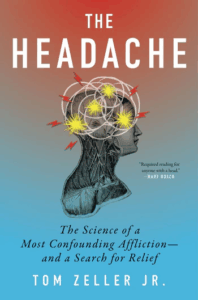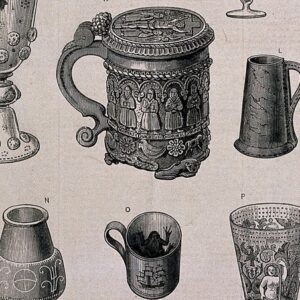
How Medical Misogyny Impacted the Treatment of Women’s Migraines
Tom Zeller Jr. Explores the Gendered Dimension of Neuroscience In the 20th Century
“I get ocular migraines, so they’re behind my eyes. And I can’t do anything when it’s bad. Like, even like the smallest light or the lightest noise sets me off. I wear sunglasses everywhere. It’s just, like, constant. I can barely open my eyes. And its just stabbing pain, like throbbing pain from behind my eyes. And I just feel so much pressure in my brain. Like, I really feel like my brain is gonna explode.”
–Emma Haggett, college student and migraine patient, Edmonton, Alberta, Canada
*Article continues after advertisement
In the spring of 1947, a traveling circus arrived for an extended stay in New York. One of the performers, a trapeze artist, suffered from headaches and sought out treatment, which eventually led her to Dr. Harold Wolff. By that time, Wolff was an established icon within neuroscience, known for his appetite for experimentation and his conviction that diseases of the mind were not distinct from those of the body—that the former could readily manifest in the latter. Simply looking at a person in the throes of a bout, or assembling accounts of self-reported symptomology, diets, and other behaviors, was not enough for Wolff, who notably suffered from migraine himself. He wanted to get inside the head—and inside the person—to discover what bits of cranial anatomy, and what bits of a patient’s life and temperament, were conspiring to create the pain.
Wolff’s work and influence, alongside a simultaneous rise in the fields of psychology and psychosomatic medicine, helped to disperse those nostrums into the wider culture.
Among other things, Wolff is responsible for one of the earliest attempts to establish the now well-known hereditability of migraine by obsessively tracing the family trees of patients. (Numbers vary, but modern population studies have shown that migraineurs are far more likely than the general population—perhaps fourfold—to have a first-degree relative who also has the disorder. Interestingly, migraine with aura appears more heritable than migraine without.) Wolff was also keen to put anecdotal remedies—however strange—to empirical test. So, when this trapeze artist reported to Wolff that her headaches could sometimes be relieved when her job required her to stand on her head, the researcher’s curiosity was piqued. He went to the circus himself to observe this head-standing behavior, and returned to the lab the next day asking his colleagues to consider what might happen inside the skull when a person is inverted. He also sent his collaborators to the circus to observe and ask the upturned acrobats questions of their own. One researcher reported finding another headache sufferer among them, who confirmed that he, too, often found some relief while upside down. Wolff had heard enough.
“He…had all of us, as well as some patients, stand on our heads,” his lab assistant would later recall. “We had a sturdy tilt table for the purpose. Prompt and vigorous vasoconstriction took place at the headend of the body which diminished the pain if you had a headache, and occasionally terminated it.” (Erasmus Darwin would no doubt have felt vindicated.)
It was just one more data point in a rich headache dossier that Wolff had compiled in the preceding decades. Having studied for a time at the Conditioned Reflex Laboratory in Russia, under experimental neurologist Ivan Pavlov, and later with psychiatrist Adolph Meyer at Johns Hopkins, Wolff eventually ended up with dual appointments at Cornell University Medical College and New York Hospital, where he would remain until his death in 1962. These early influences contributed to his interest in percolating debates about the divide between functional and organic disease—or disease that can be clearly attributed to some corporeal source vs. that with no apparent somatic aspect. Was migraine a product of the body or of the mind? Wolff, influenced by predecessors, considered this binary view of human disease too simplistic. “His interest was in moving beyond the typical Cartesian mind/body divide to understand how psyche, personality, and biology could simultaneously contribute to nervous disorders,” as Joanna Kempner puts it in her 2014 book Not Tonight: Migraine and the Politics of Gender and Health.
To that end, Wolff was a keen collector of detailed patient case studies—comprised not just of headache symptoms but family life, careers, upbringing, emotional tendencies, and other factors—which he and his team mined for meaningful patterns. Wolff was sure he’d found some, identifying personalities uniquely prone to migraines: “The elaboration of a pattern of meticulous perfectionism for dealing with feelings of insecurity begins early in childhood,” he was quoted as saying by his longtime research associate, Helen Goodell, in a lecture given after Wolff’s death in 1962. “The individual with migraine aims to gain approval by doing more than and better than his fellows through ‘application’ and ‘hard work,’ and to gain security by holding to a stable environment and a given system of excellent performance, even at high cost of energy. This brings increasing responsibility and admiration, but gains little love, and greater resentment at the pace he feels obliged to maintain. Then the tension associated with repeated frustration, sustained resentment, and growing anxiety is often followed by prostrating fatigue, the setting in which the migraine attack occurs.”
To paraphrase: Wolff seemed to think that migraine patients were well admired but relentlessly competitive high achievers who were a bit fussy, control-freakish, and prone to frustration. That Wolff himself suffered from migraines almost certainly contributed to this typology, and other descriptions of his temperament by students and peers lends credence to the idea that his notion of the migraine personality was to some extent autobiographical.
At the same time, Kempner notes that these personality traits—brilliant, competitive, overachieving—were almost always used to describe men. Kempner, a sociologist at Rutgers University who studies medicine, science, gender, and inequality, is one of those researchers presumably unleashed by the Kuhnian microscope. As a migraine patient herself, she has taken a deep interest in deconstructing the culture of headache science and the paradigms that have historically dictated what is understood as “known” in the field. For female migraineurs, she argues, Wolff had distinct impressions:
Wolff described the migrainous woman as unwilling to accept the female role, particularly in sexual relations. He described 80 percent of his female sample as sexually dissatisfied. “Orgasm was seldom attained, and the sex act was accepted, as at best, a reasonable marital duty. In several instances, it was deemed frankly unpleasant and was resented.” Furthermore, the migrainous woman was sometimes “reluctant to accept…the consequences of maternity.” In contrast, Wolff reported that his male patients were sexually well-adjusted, even if their sex drive occasionally suffered “as an accompaniment of ambition and hard application to work.” Three of Wolff’s male patients did experience “sexual maladjustment,” but Wolff pointed out that they had “vigorous sex drive[s, but]…were married to sexually indifferent or frigid wives. Women, it seems, were always the source of sexual problems.
Wolff’s attempts to find patterns to explain patients’ head pain in their personality traits were not entirely unusual in an era when Freudian psychology was capturing popular attention. Even in previous eras, doctors were quick to spot any indication of stress and nervousness in a patient and ascribe to it a certain explanatory power. It’s also worth noting that even within today’s more sophisticated, neuronal paradigm of headache, there remains plenty of room for stress, fear, worry, and other states of mind to play a role in tripping whatever wire separates bodily homeostasis from a trigeminal short circuit in any individual. These trip wires vary widely among patients; for some it may well be exceeding some threshold of stress, while for others it’s a scent or some ingested molecule.
It’s possible, albeit entirely unproven, that it all begins with the hypothalamus, the conductor leading the body’s internal orchestra. Responsible for maintaining the soft, steady music of our autonomic nervous system, the hypothalamus, through a mix of direct action or hormonal release, governs everything from body temperature and blood pressure to hunger and thirst, digestion, sleep-wake cycles, and mood. For reasons we don’t fully understand, some event, some signal arising in an invisible half moment between a systemic tick and its following tock, might be throwing the symphony into disarray. Just what precipitates the upheaval is hard to say; often it can seem to be some combination of factors in a single person, or sometimes nothing identifiable at all. What seems clear is that by some genetic predisposition that remains invisible to us, the neural latticework designed to interpret, modulate, and respond to stimuli is prone to going haywire in some people, causing a cascade of changes that very often results in head pain.
Wolff would eventually become convinced that the pain was due to dilated blood vessels in the membranous layers surrounding the brain—and he also thought patients prone to orchestral breakdown shared common traits that were more visible to the naked eye. As with the ruddy, leonine features ascribed to cluster headache patients, the midcentury retreat into migraine personality types, while understandable from the point of view of scientists and doctors struggling to explain what remained unexplainable, was always little more than nostrums filling a void. But Wolff’s work and influence, alongside a simultaneous rise in the fields of psychology and psychosomatic medicine, helped to disperse those nostrums into the wider culture—and into the prevailing paradigm within which other headache scientists and clinicians toiled.
In a lush, 1945 newspaper spread appearing in the Pittsburgh Sun-Telegraph, to take just one example, science journalist Gobind Behari Lal—who had won the Pulitzer Prize just eight years prior—reported on the latest findings regarding the female migraine personality. The package is anchored by a large image of an elegant and begowned middle-aged white woman seated in a Victorian-era armchair. Teams of hand-drawn and intentionally cartoonish baphomets come at her head from both sides armed with whips, horns, hammers, drills, and drums. One attacks her right temple with a jackhammer. Another approaches from the left with what appear to be two kitchen box graters. The title of the piece: “Beauty Is a Headache.”
In this telling, migrainous women are not so much frigid as they are clever and cute, with an abiding tendency to fret. “Women who are most easy on the eyes, charming, dazzlingly intelligent and highly sensitive,” Lal reports, “are the very ones who are particularly prone to attacks of migraine headache.” This, the journalist noted, was according to Prof. Walter C. Alvarez, on the staff of the Mayo Clinic in Rochester, Minnesota. Described as a “widely experienced and keenly observant physician,” Alvarez is quoted as saying, “Yes, I can often recognize the migrainous woman the minute I see her. This is very helpful diagnostically, because often she is rather sensitive about her handicap.”
Alvarez added: “Most of these women tend to be petite, and with nice figures.”
Forgivable or not, the residue of these facile taxonomies has been hard to scrape off the patient-doctor relationship ever since— particularly for women.
From our advantaged view of things seventy years later, it can seem almost too easy to assail past eras of scientific ignorance. They labored, after all, in the myopia of their cultural and historical moment—as do we all. At the same time, it can be hard not to marvel at certain empirical blind spots that ought not have been there by the middle of the twentieth century. As Kempner and others have pointed out, for example, such “observations” frequently suffered from first-order selection biases, with scientists basing them on the narrow and comparatively well-heeled slice of the population they had access to in their clientele. “Women who have everything are apt to have migraine,” declared the subhead of the 1945 Sun-Telegraph article.
Forgivable or not, the residue of these facile taxonomies has been hard to scrape off the patient-doctor relationship ever since— particularly for women, and even more so for women with migraines. “So, I didn’t have any of the warning signs,” Kathy O’Shea told me when I asked her about the first time she could remember getting a migraine. It was 1976, O’Shea was fourteen, and her memories are vivid: “My brother and I were off at some—we were up on the St. Lawrence River camping with my family, and we’d been over at the rec center watching, of all things, a Charlie Chaplin film, and we were sitting there on these uncomfortable seats and all of a sudden, I mean, truly out of nowhere—like, I know we always talk in metaphors when we talk about migraine, but it was just like a knife had gone through my head and I couldn’t function.”
It was the beginning of a devastating period for O’Shea, who had been active and involved in school sports for most of her life to that point. When the migraines began, however, all that shut down. Her first visit to a neurologist was devastating. “He thought that it was psychological,” she tells me. “I just remember very distinctly the first consultation, and he said to me, ‘Do you want your mother to leave the room, so you could talk to me more about what’s really going on at home?’ And I thought, what? My mother was like my best friend, first of all, and there’s nothing I can tell you that’s going to shed any light on this. So, he really was quite dismissive. And he threw me on a lot of medications that were, of course, for other things, and most of them made me very ill.”
O’Shea, a professor of English at Monroe Community College in Rochester, New York, wrote a book about migraines, published in 2020, that mines the world of literature—from Jane Austen to Joan Didion, and from Emily Dickinson to Oliver Sacks—for meaningful distillations of migraine and its lingering stigmas. While she eventually found a compassionate neurologist who alighted on a combination of therapies that worked well for her, his retirement a few years ago sent O’Shea, now in her sixties, back into the marketplace for a headache specialist. When she found one in 2018, it did not go well. “I started to get kind of emotional,” O’Shea says of a visit to this new doctor—a woman—who suggested that her prior care was all wrong and that she needed to be sent to an inpatient clinic to start over. “She didn’t back off of it. I mean, she wasn’t compassionate at all,” O’Shea said. “She just was like, ‘I’ll send you to a clinic and, you know, they’ll make you go through withdrawal from all your medications.’ It was almost like she was implying that I was some kind of addict.”
It might be overstating things to draw a line between these experiences and the wisdom of mid-twentieth-century headache researchers, but it can also be hard not to. Alvarez did seem more willing to grant charitable traits to his female patients than Wolff—he described them as being “above the average in intelligence,” for example, and “quick in understanding.” With a creepy self-assurance, Dr. Alvarez also suggested that migraine was somehow correlated with the women that men found most attractive. “Many a lovelorn male has complained that a good-looking woman gave him plenty of headaches,” the wink-wink introduction of the 1945 article on Alvarez’s theories began. “But now it turns out that it is the beauty herself who is most susceptible to the aggravating misery of the head.”
__________________________________

Excerpted from The Headache: The Science of a Most Confounding Affliction—and a Search for Relief by Tom Zeller Jr. Copyright © 2025 by Tom Zeller Jr. From Mariner Books, an imprint of HarperCollins Publishers. Reprinted by permission.
Tom Zeller Jr.
Tom Zeller Jr. is co-founder and editor-in-chief of Undark, a nonprofit digital magazine exploring the intersection of science and society. Previously, he was a reporter and columnist at the New York Times, an editor at large for National Geographic magazine, and a Knight Science Journalism fellow at the Massachusetts Institute of Technology (MIT). He lives in Lolo, Montana. The Headache is his first book.












